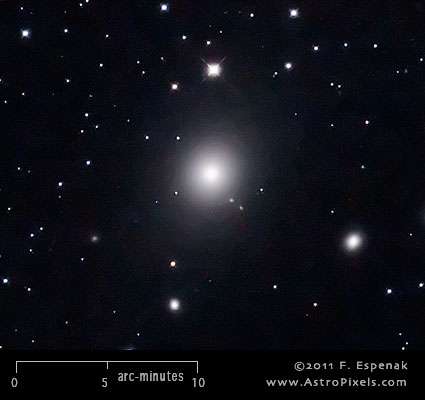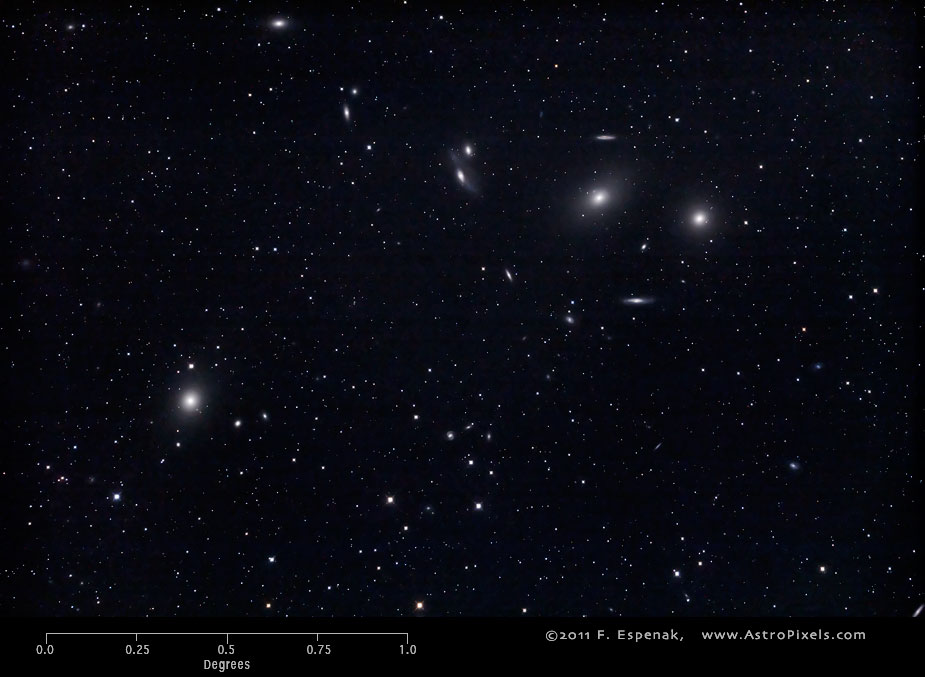
M87
Messier 87 or M87 (also designated NGC 4486) is a elliptical galaxy in the constellation Virgo. It has an apparent visual magnitude of 8.6 and its angular diameter is 7 arc-minutes. M87 lies at an estimated distance of 60 million light years. The Equinox 2000 coordinates are RA= 12h 30.8m, Dec= +12° 24´ which makes M87 best seen during the spring. The Messier Spring Star Chart shows the position of all Messier objects visible during that season.
The image above shows the uncropped view of M87 (lower left) through the Takahashi E-180 Astrograph (North is up). A 3x enlargement of this image centered on M87 appears to the right. The Virgo Cluster is rich with galaxies and more than a dozen are captured in the top image. M84 and M86 (right and left, respectively) are in the upper right while M87 is to the lower left.
This giant elliptical galaxy was discovered by Messier in 1781. Along with M49 and M87, it is one of the giant elliptical galaxies of the Virgo Cluster of galaxies. In 1918, H.D. Curtis (Lick Observatory) discovered a powerful jet of ejected gas in the core on M87 (not visible in the photo).
According to Stoyan et al. (2010), the distance of M87 is 54.9 million light years and its diameter is 132,000 light years. Its estimated mass is 2700 billion solar masses.
For more information, see the Messier Catalog as well as specific entries for M87 in Wikipedia and SEDS.
Messier's Description of M87
March 18, 1781
`Nebula without star, in Virgo, below and very near a star of eighth
magnitude, the star having the same Right Ascension as the nebula, and
its Declination was 13d 42' 21" north. This nebula appears at the same
luminosity as the two nebulae
Nos. 84 and 86.'
Technical Details
- Object: M87
- Other Names: NGC 4486
- Object Type: elliptical galaxy
- Object Data: Apparent Magnitude = 8.6, Angular Size = 7 arc-minutes
- Object Position (Equinox 2000): RA= 12h 30.8m, Dec= +12° 24´, Constellation = Virgo
- Date/Time: 2011 Apr 02 at 06:02 UTC
- Location: Bifrost Astronomical Observatory, Portal, AZ
- Mount: Astro-Physics 1200GTO
- Telescope: Takahashi Epsilon 180 Hyperbolic Astrograph
- Camera: Canon EOS 550D (Rebel T2i) (modified with a Baader UV/IR filter)
- Field of View: 1.70° x 2.56° at 1.7 arc-sec/pixel (web version: 10.0 arc-sec/pixel)
- Exposure: 4 x 300s, f/2.8, ISO 800
- File Name: M84M86M87-01w.jpg
- Processing (Adobe Camera Raw): Graduated Filter, Vignetting Correction, Noise Reduction, White Balance, Curves
- Processing (Photoshop CS5): Average Images, Curves, Noise Reduction
- Original Image Size: 3454 × 5179 pixels (17.9 MP); 11.5" x 17.3" @ 300 dpi
- Rights: Copyright 2011 by Fred Espenak. All Rights Reserved. See: Image Licensing.
